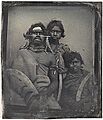Mordialloc Aboriginal Reserve facts for kids
Quick facts for kids Mordialloc Aboriginal ReserveMelbourne, Victoria |
|
|---|---|
| Population | 26 (Aboriginal people in 1869) |
| • Density | 7.72/km2 (20.0/sq mi) |
| Established | 1852 |
| Postcode(s) | 3195 |
| Area | 3.37 km2 (1.3 sq mi) |
| Guardian of the Aborigines | William Thomas |
| LGA(s) | City of Kingston |
The Mordialloc Aboriginal Reserve was a special area of land in Victoria, Australia. It was located on the coast of Port Phillip Bay. This land was the traditional home of the Bunurong people. After European settlers arrived in the 1850s, the Bunurong people gradually moved to this reserve. By the mid-1860s, most had moved or were sent to another reserve called Coranderk.
Contents
The Bunurong People's Ancient Home
The Bunurong people are part of the Kulin nation, a group of Aboriginal peoples. They lived along the eastern coast of Port Phillip Bay for over 20,000 years. Their stories tell of Port Phillip Bay flooding 10,000 years ago. They also speak of it drying up and shrinking between 2,800 and 1,000 years ago.
You can still see signs of their long history. There are shell middens (piles of shells from their meals) and hand-dug wells along the cliffs of Beaumaris. You can also find "scar trees" near Mordialloc Creek. These trees have bark removed, which the Bunurong used to make canoes.
First Encounters with Europeans
The Bunurong people first met Europeans in February 1801. This happened when the ship Lady Nelson sailed into Port Phillip Bay. Its crew landed near what is now Sorrento. In 1803, David Collins arrived there with 467 convicts. However, they left after eight months because they found the area difficult to settle.
By the 1850s, many Bunurong people moved to the Mordialloc Aboriginal Reserve. This reserve was set up in 1852. It covered about 832 acres (3.4 square kilometers) along the Mordialloc Creek and Port Phillip Bay. The Bunurong called the area Mordy yallock, meaning 'creek'. It was a favorite traditional camping spot. There was plenty of wild fowl in the Carrum Swamp and fish in the creek. However, settlers fishing upstream later made it harder for them to catch fish.
The Protectorate and the Reserve
William Thomas was a government official. He was appointed Guardian of the Yarra and Western Port tribes in 1850. He had been an Assistant Protector since 1837. From 1853, he was supposed to regularly give blankets and food to the Bunurong people. He asked a local landholder, Mr. A. V. Macdonald, to do this job at Mordialloc. Thomas told a special committee that the Bunurong people were healthy. He also said they loved the Mordialloc Aboriginal Reserve. He claimed they "want for nothing."
However, the reserve was not only for the Bunurong people. In October 1858, people complained that fishermen at Mordialloc were being charged money. They had to pay about £6 per year to set up tents on the sands. This was happening on land that was supposed to be reserved for Aboriginal people. In 1861, the reserve became part of a larger area called the Farmers' Common. This common covered about 7,960 acres (3,221 hectares).
Challenges and Changes
In 1861, there was a sad event. An Aboriginal woman named Betsy and her newborn baby died from cold and lack of food. This news caused public anger. Because of this, George Harris Warren was appointed in March 1862. He was an 'honorary correspondent' at Mordialloc. His job was to report on how food and supplies were given out. He reported to the Central Board for Watching over the Interests of the Aborigines. This Board was created in 1860.
On May 31, 1869, the Board estimated the number of Aboriginal Australians in reserves in Victoria. There were 1,834 people in total. Only 26 of them were at Mordialloc. A song man named Kubaru from the Bunurong Mordialloc tribe had a dream. In his dream, his totem, the koala, showed him a great disaster for his people. He said, "All gone dead." Sadly, Nancy and Jimmy Dunbar died in 1877. They were the last Bunurong people from the Mordialloc camp.
In 1878, the Minister of Lands made a decision. George Langridge wanted to use 10 acres (4 hectares) at Mordialloc. This land was thought to be part of the Aboriginal reserve. However, the Minister said that the Lands department had never officially set aside that land for Aboriginal people.
Images for kids







